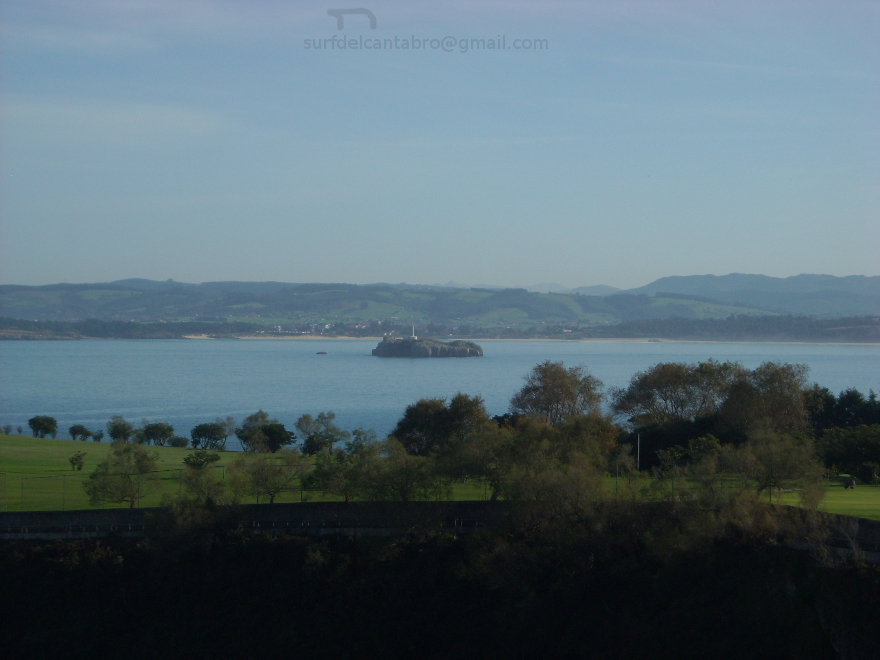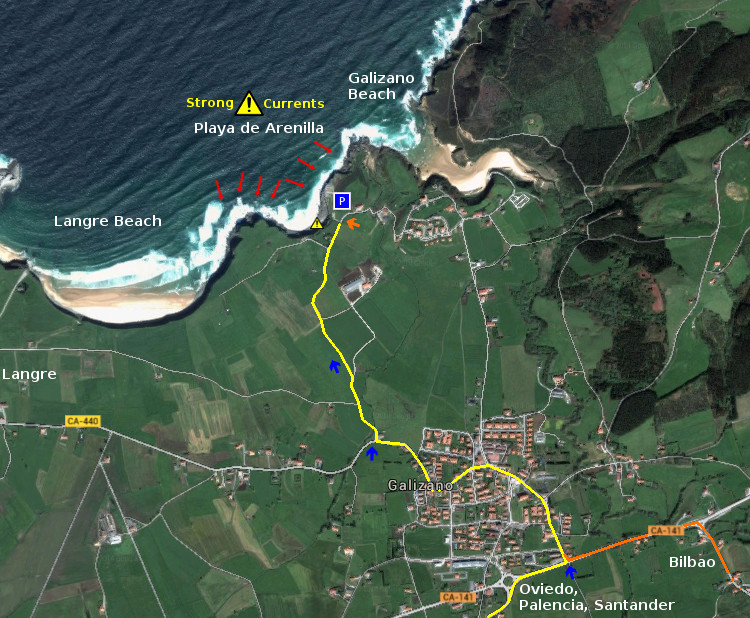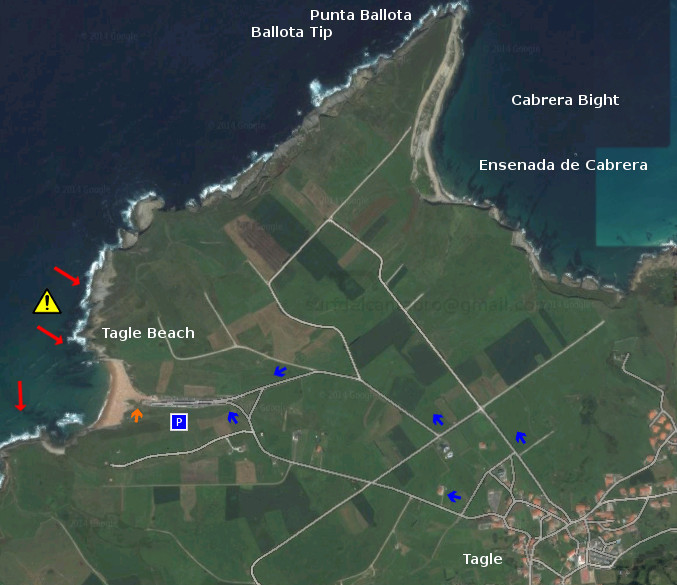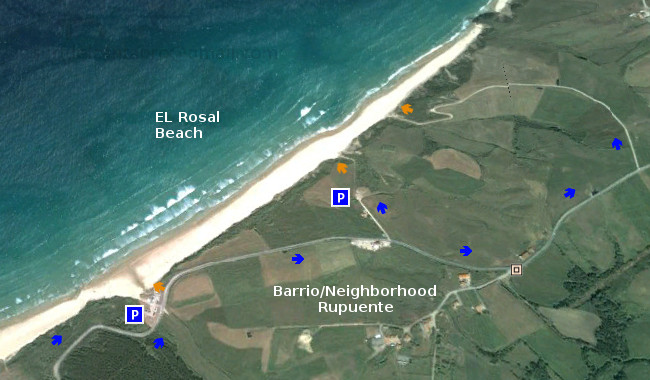Momentos de Liencres. Sabado, amanecer
![]() A las siete de la mañana ya había amanecido. Unos rayos de sol entraban por la ventana, proporcionando un dulce despertar. El día para nuestra sesión de surf había llegado. Preparé el equipo y cargué todos los materiales en el coche. El día anterior nos citamos a las ocho en la Plaza de Numancia. Me dirigí al punto de encuentro. La ciudad a esas horas estaba con poca circulación. Santander vivía un día festivo, con todos los comercios cerrados.
A las siete de la mañana ya había amanecido. Unos rayos de sol entraban por la ventana, proporcionando un dulce despertar. El día para nuestra sesión de surf había llegado. Preparé el equipo y cargué todos los materiales en el coche. El día anterior nos citamos a las ocho en la Plaza de Numancia. Me dirigí al punto de encuentro. La ciudad a esas horas estaba con poca circulación. Santander vivía un día festivo, con todos los comercios cerrados.
De camino a la plaza, la ausencia de coches en las carreteras y el Sol posando sobre las calles, causaban unas sensaciones especiales que acompañaban el recorrido. Al llegar al lugar, dos colegas estaban esperando. Introducimos con destreza los materiales en el vehículo. Otra gente se acercaría a la playa más tarde. Con la música sonando en el coche y conversando de olas, atravesamos la ciudad. En la rotonda de Corbán se aglutinaban más vehículos, colapsando el cruce. Parecía que todo el mundo había pensado lo mismo, disfrutar del buen fin de semana que se presentaba. Al paso por la localidad de Liencres, el último semáforo de camino a la playa; se cerró. En una plaza, anexa a la carretera, había varias carpas y puestos de venta ya montados. La luz del día lucía la celebración de la festividad en la localidad. Una cola de vehículos esperábamos la luz verde del semáforo para continuar el trayecto. Varias caravanas y un par de furgonetas cerraban la hilera. La señal se abrió, continuamos ordenadamente, conformando una imagen bucólica incrustados en el paisaje y el ritmo de avance. A tres kilómetros de la playa, las emociones iban picoteando el estomago. La carretera que cruza el Pinar de la Dunas de Liencres, suponía el último paso antes de llegar a la playa.
Entramos primero al aparcamiento de Canallave. Su media ocupación hacia pensar en un buen día de surf. Surfers vistiendo el traje de neopreno, otros de camino al agua y un numeroso grupo de riders ya en el mar. Imágenes que reflejaban la preparación hacia las olas. La bajamar sucedió a las seis de la mañana. La playa mostraba el fondo rocoso e irregular. Las ondas hábiles aparecían en un par de picos lejanos, situados a seiscientos metros de la entrada. Asomados a la punta que separa las dos playas, fuimos estudiando las posibilidades. A la izquierda Valdearenas mostraba varios picos de olas cercanos. Bajamos con el coche hasta el aparcamiento principal. Las plazas próximas a la entrada estaban ya ocupadas.Estacionamos el vehículo a media distancia. Mientras cada uno de nosotros preparaba su equipo, charlábamos sobre las mejores zonas. En la conversación apareció el tema de las corrientes fuertes, presentes en la zona. Hablábamos de evitar los lugares adyacentes al final del arenal y las rocas de la entrada.
De pies sobre la arena, mirando al Mar Cantábrico, imaginaba olas ideales a lo largo de la jornada. Olas definidas, largas, practicables y seguras. No pensaba en sus tamaños, sólo en la calidad. Sobre el agua, las series llegaban con ocho de período y metro y medio de altura. A lo lejos, en la parte izquierda, el mar golpeaba con fuerza las rocas de Robayera. El agua salía despedida en el aire, siendo visible a un kilómetro de distancia. Después de calentar los músculos, entramos al agua. El oleaje que llegaba hasta la orilla dificultaba el avance y hacia sentir en cada paso la fuerza de la corriente. Tras treinta metros, el agua cubría hasta la altura del cuello. Una ola rezagada se abalanzó sobre mí. Buceando, con la tabla a un lado, evité su elevación. Me moví hacia el lateral del pico de olas. Remando con fuerza y haciendo la cuchara, conseguí llegar hasta una zona tranquila; a la que habían llegado los demás.
Flotando sobre el agua, con los brazos extendidos, descansé durante unos minutos. Doscientos metros de agua hasta llegar a la arena, reducían la visión de los objetos a pequeñas figuras. En aquella posición, las olas nacían con apenas un metro. Corrían la mitad del trazado, aumentando progresivamente el tamaño. Unos instantes después aparecía un rizo sobre ellas que se desplazaba a izquierda o derecha. Terminaban estas su viaje a cincuenta metros de la orilla. Permanecimos sentados, esperando que llegara una ola más grande. Por lo visto hasta aquel momento, podía suponer un trayecto superior a cien metros. Subiendo y bajando a la cresta, maniobrando con tiempo y libres sobre el agua. El Sol se ocultaba detrás de unas nubes que dejaban pasar algún rayo de luz. La sombra que procuraban las dunas y el pinar, conservaban el agua aun fría que contrastaba con la excitación de los que estábamos en el mar.
Moments of Liencres. Saturday, dawn
![]() At seven o’clock in the morning already it had dawned. A few beams of the Sun were entering the window, providing a sweet to wake up. The day of our surf session had come. I prepared the equipment and loaded all the materials in the car. The previous day we arrange an appointment at eight o’clock, in the Square of Numantia. I went to the point of meeting. The city at those hours was with few traffic. Santander had a holiday, with all the closed trades.
At seven o’clock in the morning already it had dawned. A few beams of the Sun were entering the window, providing a sweet to wake up. The day of our surf session had come. I prepared the equipment and loaded all the materials in the car. The previous day we arrange an appointment at eight o’clock, in the Square of Numantia. I went to the point of meeting. The city at those hours was with few traffic. Santander had a holiday, with all the closed trades.
On the way to the square, the absence of cars in the roads and the Sun posing on the streets; were causing special sensations that were accompanying the tour. On having come to the place, two colleagues were waiting. We introduce nimbly the materials in the vehicle. Another people would approach the beach later. With the music in the car and talking about waves, we cross the city. In roundabout of Corbán, more vehicles were arriving, collapsing the crossing. It seemed that the whole world had thought the same thing, to enjoy of the good weekend that one was presenting. Through Liencres’s locality, the last semaphore of way to the beach; was closed. In a small square that was near the road, there were several tents and already mounted market stalls. The daylight was illuminating the celebration of the festivity in the locality. A tail of vehicles were waiting for the green light of the semaphore to continue the travel. Several caravans and a couple of vans were closing the row. The sign was opened, we continue tidily, shaping a bucolic image incrusted in the landscape and the pace of advance. To three kilometres of the beach, the emotions were pecking the stomach. The road that crosses the Pinegrove of Liencres’s Dunas, supposed the last step before coming to the beach.
We enter first to Canallave’s parking. His half occupation towards thinking in the good day of surf. Some surfers were dressing the wetsuits, others were walking to the water and a numerous group of riders were already in the sea. All these Images were reflecting the preparation towards the waves. The low tide happened at six o’clock in the morning. The beach was showing the rocky and irregular bottom. The skilful waves were appearing in a couple of distant beaks, placed to six hundred meters of the entrance. Overlooking the top that separates both beaches, we were studying the possibilities. To the left side Valdearenas it was showing several nearby beaks of waves. We went down with the car up to the main parking. The parking spaces near the entry were already busy. We park the vehicle to half a distance. While each of us was preparing his equipment, we were chatting about the best zones. In the conversation there appeared the topic of the strong, present currents in the zone. We were speaking of avoiding the adjacent places at the end of the sandbank and the rocks of the entry.
On the sand, looking to the Cantabrian Sea, I was imagining ideal waves along the day. Definite, long, practicable and sure waves. He was not thinking about his sizes, only about the quality. On the water, the series were arriving with eight of period and meter and a half of height. In the distance, in the left part, the sea was striking strongly Robayera’s rocks. The water was shot and was dismissed in the air, being visible to a kilometre of distance. After warming the muscles, we enter to the water. The surge that was coming up to the shore was impeding the advance and had been making to feel its intensity in every step. After thirty meters, the water was covering up to the height of the neck. A lazy wave rushed on me. I dived, with the board aside, I avoided its elevation. I moved towards one wing of the beak of waves. I rowed hard and I did the duck, I managed to come up to a calm zone; to which the others had come.
Floating on the water, with the widespread arms, I rested during a few minutes. Two hundred meters of water up to coming to the sand, were reducing the vision of the objects to small figures in the sand. In that position, the waves were born with scarcely a meter. Them were traversing until the half of the tracing, increasing progressively the size. A few instants later a curl was appearing on them, that was been displacing sometimes to left side or right. Them were finishing his trip to fifty meters of the shore. We remained seated, hoping that a bigger wave would come. Apparently up to that moment, it could suppose a distance higher to hundred meters. Rising and going down to the comb, maneuvering with time and free on the water. The Sun was hiding itself behind a few clouds that were allowing to spend some beam of light. The shade that the dunes and the pinegrove were giving were preserving the cold temperatuee of the water, that was contrasting with the excitation that each one had in the sea.
![]()















